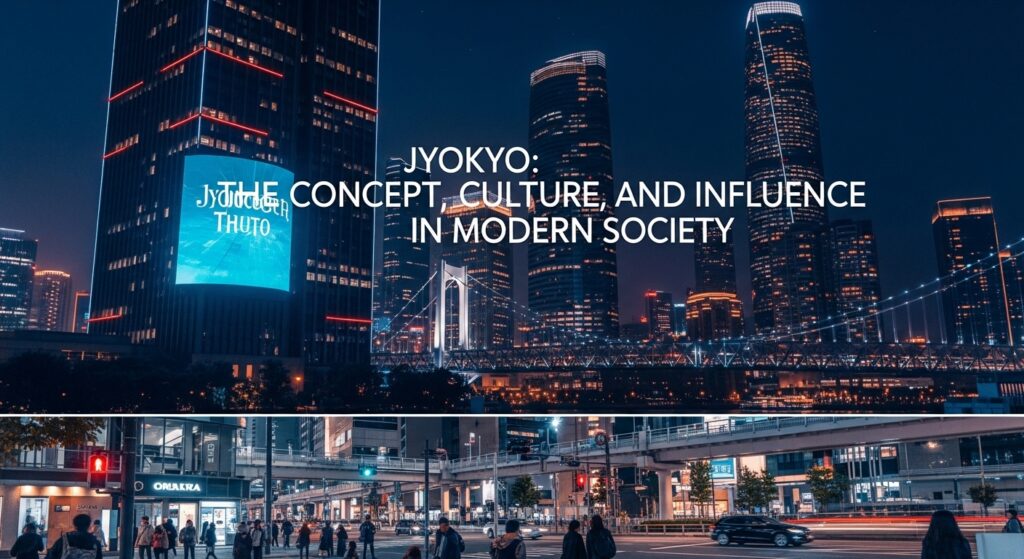The term Jyokyo carries deep meaning in various cultural, artistic, and social contexts. In its essence, Jyokyo reflects a state of being or situation that connects emotion, environment, and human expression. Originating from Japanese philosophy and aesthetics, Jyokyo emphasizes the harmony between one’s inner world and external circumstances. This article explores Jyokyo from multiple dimensions—its roots, applications, and influence in today’s world.
Understanding the Meaning of Jyokyo
At its core, Jyokyo translates to “situation” or “state,” yet its meaning transcends simple translation. It represents the atmosphere or condition surrounding an experience. In traditional Japanese literature and philosophy, Jyokyo expresses the emotional tone of a scene—how the setting and the individual’s feelings merge into a single poetic experience.
| Aspect | Description |
|---|---|
| Language Origin | Japanese, derived from “Jyo” (state) and “Kyo” (condition or situation) |
| Literal Meaning | Situation, atmosphere, or emotional setting |
| Philosophical Essence | The relationship between environment and emotion |
| Cultural Use | Literature, film, design, and aesthetics |
Jyokyo, therefore, is not only about external surroundings but also the emotional and psychological connection that defines human perception.
The Cultural Significance of Jyokyo
In Japanese culture, Jyokyo holds immense importance. It defines the subtle beauty of moments that exist between joy and melancholy. Whether in a serene garden, a minimalist tea ceremony, or a fleeting moment of reflection, Jyokyo shapes the emotional temperature of an experience.
In ancient times, poets and artists used to express sentiments that words alone could not convey. The Japanese notion of mono no aware—the awareness of impermanence—is closely related to Jyokyo. Both concepts highlight sensitivity to surroundings and the emotions that arise from them.
Jyokyo in Art and Literature
Art and literature are where truly comes alive. In traditional haiku poetry, for instance, the author often captures not just an image but an atmosphere—a feeling tied to a specific time, place, and emotion.
In visual arts, Jyokyo manifests through composition, lighting, and spatial arrangement. Japanese painters and calligraphers often leave empty spaces—known as ma—to evoke the mood or of the piece.
| Art Form | How Jyokyo Appears |
|---|---|
| Haiku Poetry | Evokes emotion through seasonal imagery and brevity |
| Calligraphy | Balance and rhythm reflect emotional flow |
| Painting | Space, tone, and color create a specific emotional atmosphere |
| Cinema | Scene composition mirrors character emotion |
Modern Japanese filmmakers, such as Yasujirō Ozu and Hirokazu Kore-eda, use to tell stories that connect ordinary life to universal emotions. Their films do not rely on drama but on subtle expressions of human experience—perfect embodiments of.
Philosophical Foundations of Jyokyo
The philosophy behind Jyokyo is grounded in mindfulness and awareness. It teaches that every situation, no matter how simple, carries emotional weight. By acknowledging, individuals can live more harmoniously and with greater empathy toward their surroundings.
From a Zen perspective, encourages people to be present in the moment. It is not about controlling one’s environment but about sensing it deeply and responding with awareness. This approach fosters balance, patience, and a deeper connection with life.
Modern Applications of Jyokyo
In today’s digital age, the concept of Jyokyo has found new relevance. Designers, filmmakers, and even marketers use the idea of to create experiences that evoke specific emotions.
In architecture, influences the relationship between space and human comfort. Japanese interior designs often emphasize natural light, texture, and simplicity to create calming atmospheres. Similarly, in photography, guides the photographer’s focus on mood rather than mere aesthetics.
| Field | Application of Jyokyo |
|---|---|
| Architecture | Designing spaces that harmonize with nature |
| Photography | Capturing the emotional context of a scene |
| Film & Media | Using tone and lighting to evoke emotional resonance |
| Marketing | Creating emotional connections between brand and audience |
This shows that has moved beyond art—it now shapes how humans interact with design, storytelling, and even technology.
Jyokyo and Emotional Intelligence
Another fascinating aspect of Jyokyo is its relationship with emotional intelligence. Understanding involves being aware of emotional cues in different contexts, allowing individuals to respond empathetically. In leadership, communication, and relationships, this sensitivity can create stronger connections and mutual understanding.
For instance, in business meetings or cross-cultural communication, being mindful of the—the emotional atmosphere—helps navigate conversations with tact and respect. It promotes harmony and reduces misunderstandings.
Jyokyo in Daily Life
Integrating Jyokyo into daily life can lead to a more balanced and mindful existence. Simple practices such as observing nature, listening with intention, and appreciating silence can help one sense the of their environment.
Here’s how you can cultivate awareness:
| Practice | Impact on Jyokyo Awareness |
|---|---|
| Mindful Observation | Heightens emotional sensitivity to surroundings |
| Minimalist Living | Reduces distractions and fosters clarity |
| Journaling Emotions | Encourages reflection on inner states |
| Nature Walks | Strengthens connection between mind and environment |
Through these practices, individuals can experience deeper appreciation for ordinary moments—transforming routine into reflection.
Comparing Jyokyo with Western Concepts
While Jyokyo has no direct equivalent in English, it shares similarities with certain Western ideas like atmosphere, mood, or aesthetic. However, what makes distinct is its focus on unity between external environment and internal feeling.
Western aesthetics often separate observer and object, while dissolves that boundary, merging perception with presence. This perspective enriches understanding of emotion, design, and art beyond surface beauty.
| Concept | Origin | Focus |
|---|---|---|
| Jyoko | Japanese | Emotional harmony between self and environment |
| Mood | Western | Emotional tone of a situation |
| Atmosphere | Western | Surrounding tone or physical feeling |
| Zen Mindfulness | Japanese | Awareness and balance in the present moment |
The Global Influence of Jyokyo
The reach of has extended beyond Japan. In global art, design, and wellness movements, its philosophy resonates deeply. Minimalist architecture, nature-based design, and emotional storytelling all reflect Jyokyo’s influence.
Western creatives often integrate-like ideas to create depth and authenticity in their work. From mindfulness apps to cinematic storytelling, the concept enhances how people engage emotionally with digital and physical spaces.
Conclusion
In a fast-paced world filled with noise and distraction, invites us to slow down and sense the subtle layers of our experiences. It reminds us that true beauty lies not in perfection but in presence. Whether through art, design, or everyday living, embracing leads to richer emotional awareness and harmony with our surroundings.
By understanding , we learn to appreciate the invisible connections between emotion and environment—creating a life not just seen, but deeply felt.






